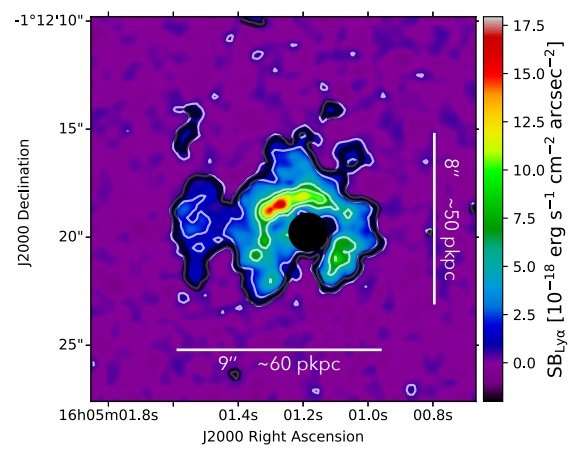February 20, 2018 report
Lyman-alpha emission detected around quasar J1605-0112

Using the Multi Unit Spectroscopic Explorer (MUSE) instrument astronomers have discovered an extended and broad Lyman-alpha emission in the form of a nebula around the quasar J1605-0112. The finding is reported February 9 in a paper published on the arXiv pre-print repository.
J1605-0112 is a radio-quiet quasar at a redshift of 4.92. Astronomers have classified this object as one of the broad absorption line (BAL) quasars. Although BAL quasars have been studied for over 30 years, researchers are still uncertain why broad absorption lines are observed in such objects.
In order to understand this phenomenon, a European team of astronomers led by Michele Ginolfi of the Rome Observatory, Italy, has conducted an observation campaign using the MUSE wide integral field spectrograph installed on ESO's Very Large Telescope (VLT) in Chile. They employed this instrument to reveal more insights into the nature of BAL quasars and to analyze Lyman-alpha emission surrounding such objects.
MUSE observations carried out by Ginolfi's team resulted in identifying a Lyman-alpha emission around J1605-0112, forming a nebula surrounding this quasar.
"In this work, we report deep MUSE observations of a Broad Absorption Line (BAL) quasar at z ~ 5, revealing a Lyα nebula with a maximum projected linear size of ~60 kpc around the quasar," the researchers wrote in the paper.
As noted in the study, this nebula is nearly 200,000 light years in size. Therefore, it appears to be smaller than typical nebulae detected with MUSE around quasars at lower redshifts (between three and four), which are usually more than two times larger. The researchers assume that such size discrepancy is intrinsic and not an artifact of the cosmological surface brightness dimming.
The study found that the circularly averaged surface brightness radial profile of the newly detected nebula shows a steeper slope than typical nebulae at lower redshifts and indicates a less extended gas distribution. However, the authors of the paper added that single nebulae at lower redshift show a large variability in terms of radial profiles.
Furthermore, the researchers emphasize that the velocity dispersion map of the Lyman-alpha emission shows a particularly high broadening of the line in the inner regions of the nebula—higher than usually observed in similar nebulae. "Differently from the typical nebulae around radio-quiet non-BAL quasars, in the inner regions (~10 kpc) of the circumgalactic medium (CGM) of our source, the velocity dispersion of the Lyα emission is very high (FWHM > 1,000 km s−1 )," the paper reads.
The researchers try to explain such high broadening of the Lyman-alpha line, attributing it to the BAL nature of J1605-0112. They suggest that this broadening may trace both highly turbulent circumgalactic gas as well as outflowing material escaped from the galaxy.
"The large FWHM of the Lyα may directly trace the large scale outflow associated with the BAL. Even if the Lyα is not directly tracing the outflow gas, as suggested by the null detection of the CIV line, possibly pointing to a low gas metallicity, the outflow can anyhow introduce significant turbulence into the CGM which may result in the observed broadening," the astronomers concluded.
More information: Extended and broad Lyman alpha emission around a BAL quasar at z~5, arXiv:1802.03400 [astro-ph.GA] arxiv.org/abs/1802.03400
Abstract
In this work we report deep MUSE observations of a Broad Absorption Line (BAL) quasar at z ~ 5, revealing a Lyman alpha nebula with a maximum projected linear size of ~ 60 kpc around the quasar (down to our 2-sigma SB limit per layer of ~ 9e-19 erg/s/cm^2/arcsec^2 for a 1 arcsec^2 aperture). After correcting for the cosmological surface brightness dimming, we find that our nebula, at z ~ 5, has an intrinsically less extended Lyman alpha emission than nebulae at lower redshift. However, such a discrepancy is greatly reduced when referring to comoving distances, which take into account the cosmological growth of dark matter (DM) haloes, suggesting a positive correlation between the size of Lyman alpha nebulae and the sizes of DM haloes/structures around quasars. Differently from the typical nebulae around radio-quiet non-BAL quasars, in the inner regions (~ 10 kpc) of the circumgalactic medium (CGM) of our source, the velocity dispersion of the Lyman alpha emission is very high (FWHM > 1000 km/s), suggesting that in our case we may be probing outflowing material associated with the quasar.
© 2018 Phys.org



















